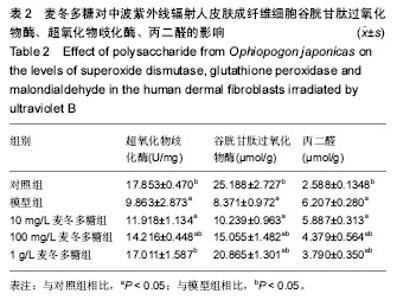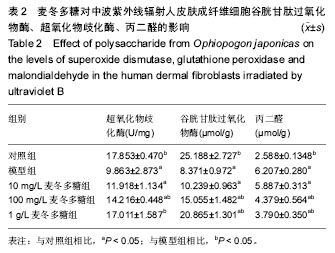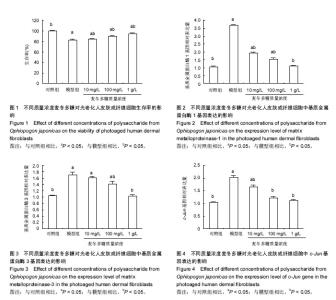| [1] 殷花,林忠宁,朱伟. 皮肤光老化发生机制及预防[J]. 环境与职业医学,2014,31(7):565-569.[2] 曹爽,付绍智,王永多, 等.麦冬多糖药理作用研究进展[J]. 安徽农业科学,2015,43(28):63-66. [3] 杨金颖,孙芳芳. 麦冬多糖的药理作用研究[J]. 天津药学,2016, 28(2):52-55.[4] Yu BC, Lee DS, Bae SM, et al. The effect of cilostazol on the expression of matrix metalloproteinase-1 and type I procollagen in ultraviolet-irradiated human dermal fibroblasts. Life Sci. 2013;92(4-5): 282-288.[5] 李春雨,张丽宏,张宁,等. 紫外线诱导皮肤光老化的形成机制[J]. 中国美容医学, 2009,18(3): 416-419.[6] Fisher GJ. The pathophysiology of photoaging of the skin. Cutis. 2005;75(2 Suppl): 5-8, 8-9.[7] 马淑梅, 刘晓冬, 龚平生, 等. 中波紫外线对成纤维细胞的损伤作用[J]. 吉林大学学报,2005,31(3):365-367.[8] 王玉贞,郭沈波,韩华, 等.中波紫外线诱导人真皮成纤维细胞凋亡的研究[J]. 青岛大学医学院学报,2002,38(4):287-288+306.[9] 陈默,赵亚,孙懿. 杜仲预防UVB致人成纤维细胞光老化的作用及基因水平的机制探讨[J]. 日用化学工业,2016,46(1): 35-38+57.[10] 郑雯,曾维惠,易清玲,等.白藜芦醇对UVB照射的人皮肤成纤维细胞MMP-1水平及细胞凋亡的影响[J]. 中国皮肤性病学杂志, 2012,26(4):296-299.[11] 骆丹,明亚玲,徐晶, 等.UVB致成纤维细胞损伤及两种中药的保护作用研究[J]. 中国皮肤性病学杂志,2006,20(7):385-388.[12] 吴迪,周炳荣,骆丹. 黄芩苷对UVB诱导人皮肤成纤维细胞光产物生成的干预作用[J]. 中国中西医结合皮肤性病学杂志,2011, 10(5):273-275.[13] 王小勇,毕志刚,王云贵,等.人参皂苷和枸杞多糖对UVB诱导培养的成纤维细胞提早衰老的影响[J].中华皮肤科杂志.2010,43(3): 184-187.[14] 李丹晖,宋坪,张文生.人参皂苷Rg1对UVB损伤PG12及成纤维细胞的保护作用[J]. 皮肤病与性病,2009,(4):6-9.[15] 黄光辉,孙连娜. 麦冬多糖的研究进展[J]. 现代药物与临床, 2012,(5):523-529.[16] 范俊,张旭. 麦冬多糖药理研究进展[J]. 中医药学刊,2006,(4): 626-627.[17] Wolfle U, Seelinger G, Bauer G, et al. Reactive molecule species and antioxidative mechanisms in normal skin and skin aging. Skin Pharmacol Physiol. 2014;27(6): 316-332.[18] Rinnerthaler M, Bischof J, Streubel MK, et al. Oxidative stress in aging human skin. Biomolecules. 2015;5(2): 545-589.[19] Kammeyer A, Luiten RM. Oxidation events and skin aging. Ageing Res Rev. 2015;21: 16-29.[20] Scharffetter-Kochanek K, Brenneisen P, Wenk J, et al. Photoaging of the skin from phenotype to mechanisms. Exp Gerontol. 2000;35(3): 307-316.[21] Fisher GJ, Voorhees JJ. Molecular mechanisms of photoaging and its prevention by retinoic acid: ultraviolet irradiation induces MAP kinase signal transduction cascades that induce Ap-1-regulated matrix metalloproteinases that degrade human skin in vivo. J Investig Dermatol Symp Proc. 1998; 3(1): 61-68.[22] Montagner S, Costa A. Molecular basis of photoaging. An Bras Dermatol. 2009;84(3): 263-269.[23] Wlaschek M, Tantcheva-Poor I, Naderi L, et al. Solar UV irradiation and dermal photoaging. J Photochem and Photobiol B. 2001;63(1-3):41-51.[24] Lopez-Camarillo C, Ocampo EA, Casamichana ML, et al. Protein kinases and transcription factors activation in response to UV-radiation of skin: implications for carcinogenesis. Int J Mol Sci. 2012;13(1):142-172.[25] 刘平,杨荣丽,苏慧,等. 红外线影响人皮肤成纤维细胞中c-Jun、Ⅰ型和Ⅲ型胶原的表达[J]. 南方医科大学学报,2016,36(2): 163-169.[26] Sardy M. Role of matrix metalloproteinases in skin ageing. Connect Tissue Res. 2009;50(2): 132-138.[27] Quan T, Qin Z, Xia W, et al. Matrix-degrading metalloproteinases in photoaging. J Investig Dermatol Symp Proc. 2009;14(1): 20-24.[28] Naylor EC, Watson RE, Sherratt MJ. Molecular aspects of skin ageing. Maturitas. 2011;69(3): 249-256.[29] Quan T, Qin Z, Xia W, et al. Matrix-degrading metalloproteinases in photoaging. J Invest Dermatology Symposium Proceedings. 2009;14(1):20-24.[30] 陆洪军,宋丽娜,付天佐,等. 麦冬多糖对亚急性衰老小鼠皮肤组织衰老程度的影响[J]. 中国老年学杂志,2015,35(8): 2160-2161. |



